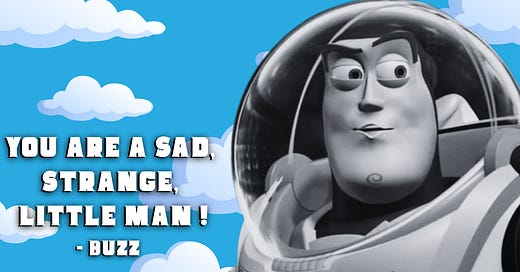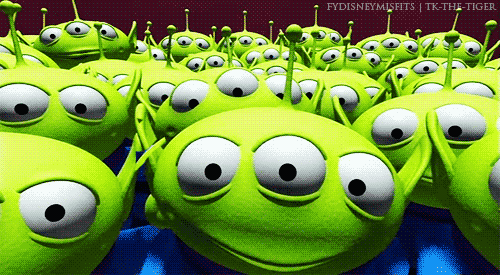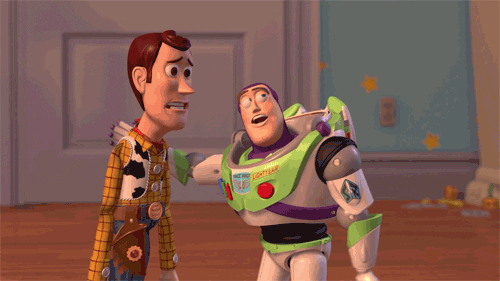For a significant part of my childhood I fully believed my toys had their own secret lives and that they watched out and cared for me with the same intensity I cared for them. My assortment of stuffed animals, ‘teddies’ as I called them, benefitted particularly from my conviction that they were sentient and sentimental beings, even if this was never revealed to the human eye. I would regularly hold council with my teddies, all of whom had names, sitting them round in a circle and consulting them on issues of import to our “family.”
So when, at age 11, Toy Story came along and revolutionised children’s animated features it felt more like a documentary than a work of fiction. I was a little too old by then to really believe my toys came alive when I was asleep or at school, but young enough to feel gratified that I was not the only one this scenario had occurred to.
Welcome to AutCasts, a free newsletter exploring neurodivergence through cinema’s oddballs, misfits & rebels!
Toy Story is a 1995 American animated children’s comedy movie set in a world where Toys are sentient beings who come alive when there are no humans around. Woody (Tom Hanks), a vintage pull-string cowboy doll, becomes profoundly jealous when his human, Andy, gets a a new spaceman action figure, Buzz Lightyear (Tim Allen) for his birthday. It is not long before Buzz, who thinks he’s a real space ranger, supplants Woody as Andy’s favourite toy. While Buzz remains in absolute denial of his toy status Woody tries to regain his place as Andy’s favourite and leader of the other toys, by plotting against Buzz. When they fall into the hands of the sadistic teenage neighbour, Sid, just two days before Andy and his family move house, Buzz and Woody must put aside their differences and find a way back to Andy.
We toys can see everything…
I’m sure I must have seen Toy Story in the cinema, as it came out when I was 11 and, a year or two shy of the thick shell of teenage cynicism I would take great pains to build around me. It was the summer sensation that everyone had to see, not least because it was the first full-length computer animated film ever made. And, as you would expect for a movie about toys, the merch was almost as big as the movie itself. From Happy Meals to life-size Buzz Lightyears complete with laser beam and utility belt you too could hold a piece of the movie in your hands, and we did, gladly!
My abiding memory, however, is of watching Toy Story six times in one weekend at my father’s house. There was nothing unusual about us watching six movies during our fortnightly visitations. We had a regular rotation of Mel Brooks classics recorded from the TV interspersed with the one rental VHS we were allowed to pick for the weekend. The unusual thing was watching the same movie six times in one weekend and not, apparently, going stir crazy.
There were no Blockbusters or Xtra Visions in the tiny seaside village in North Kerry where my father lived. Rather, there was a shop/post-office with a floor to ceiling shelf of VHSs stocked mostly with 1980s action movies starring Arnold Schwarzenegger and Sylvester Stallone. The very top shelf was reserved for porn, which we all judiciously pretended not to notice. In a town of barely 200 inhabitants, I often wondered who exactly had the nerve to rent anything off the top shelf?
The children’s movies were split between Disney Classics and Macauly Culkin’s full back catalogue. You would be hard pressed to find a movie from the previous year, let alone a new release. But on one of those weekends in the winter of 1996 Toy Story appeared and we snapped it up along with our Friday night frozen pizza. Between then and Sunday evening, when we got the bus back to our mother’s house, we managed to fit in six full screenings.
Rewatching favourite movies or TV shows, is something I find both comfort and joy in, as do many autistic people. The ones I’m drawn to rewatching most form the basis of this newsletter. Nevertheless, I tend to space my viewings out between months or years rather than watch the same movie back-to-back. I can only surmise that the magic of Toy Story mixed with the forced separation from our beloved toys for two nights (we could only bring the toys we could carry on the bus with us) kept us hooked to the TV. I don’t remember getting bored of the repeated viewings, nor my father appearing at all to tell us to switch it off, get dressed and go play or read a book. It was one way, I suppose, to keep three city kids busy in a tiny house in the middle of nowhere where we had no friends, the only neighbours were cows and the adult in charge spent most of the day in bed.
A stupid, little, insignificant toy?
Toy Story is a movie made to toy scale with adult-size stakes about identity, community and family. Buzz is delusional, unable to recognise he is not a space ranger, but a mass-produced toy. Woody is a control freak who is obsessed about the rules and displays an anxious attachment to his human Andy. Buzz’s arrival spells a crises for Woody as novelty and modernity, plastics and gimmick, replace “traditional values” and natural materials. As they vie for the position of “top toy” Buzz and Woody embody the clash between two frontiers that have characterised US colonial expansion from its inception: The American West and Space. In learning to stop competing and work together, the audience is reassured that despite any perceived conflict of interest, the US will continue to dominate on land and in space, forging an alliance between traditional values and modern technology that has played out in the most grotesque and perturbing ways over the last few years.
Wow, that got meta very quickly! But if you’ve been following this newsletter for any length of time you’ll know that imperialism is never far from my mind…
So, why do I like Toy Story?
Toy Story is about celebrating play, imagination, learning to accept yourself and community cooperation. It’s a movie which recognises the importance of toys, not as a consumer item to be accumulated (although the merchandising around the movie certainly pushes that agenda), but as a source of connection and imagination, where the bond between Andy and his toys, as well as the community of toys themselves, is foregrounded.
The toys help each other and keep each other safe, while also showing how attuned they are to different communication and mobility capacities and needs. These are not seen as deficits, but assets. Sketch is non-speaking but can draw up elaborate plans using the two dials and his screen and Slinky Dog’s flexibility allows the other toys to reach places they might not otherwise be able to get to.
Certain hierarchies do exist, not least the two male dolls, who occupying the top wrung in terms of decision making and as the objects of Andy’s affection. It’s also a very gendered space with the only traditionally ‘girl’ toys to be found in Andy’s room being Bo Peep and, from Toy Story 2 onwards, a Mrs. Potato Head. I would also argue that Sid gets a raw deal. Is he really a torturer of toys or just the weird art kid with a slightly disjointed imagination?
You Are A Child’s Plaything!
Alongside books, toys were the principal material that fuelled my imagination as a child. Creating universes of adventure with my toys was a central feature of my childhood. Toys were also a comfort and my favourite teddy or Barbie would accompany me wherever I was allowed to bring them - generally everywhere but school. Like many autistic people, I have a fraught relationship with the subject of play, toys and childhood transitions.
Autism and play are a focus of intense scrutiny, with many neurotypical assumptions based on the “right ways” to play, the “right age” to play with certain toys, so-called “unhealthy attachments” to objects and “right age” to move on from toys altogether. And while Toy Story does fall into some of these traps, it ultimately explores the nature of growth and transitions and while respecting children’s emotional and imaginative attachment to toys. Given that most diagnostic processes still centre around autistic (male, white) children, there’s a tremendous fixation on the play patterns of autistic people and their relationship to toys. We get asked questions like, did we line up our toys as kids, as if that one habit is going to crack the diagnosis for us.
I didn’t line my toys up as far as I can recall, in fact the mess that was my bedroom, and by extension my toys, was a point of tension with my mother throughout my childhood and adolescence. But my toys all had a place, my Barbies in their suitcase and my teddies in a crown around my pillow threatening to smother me at night.
They all had names, personalities, roles and functions. There were the ones I took out of the house and the ones I cuddled at night, the ones I actively played with, like Barbie, the ones that were just there because I got them as presents for my birthday or Christmas. There was a considerable amount of 90s cartoon merch (crap?) shared between my brothers and I, like a full set of Teenage Mutant Hero Turtles including Kang with his removable brain, Captain Planet and all his Planeteers, The Ghostbuster team complete with proton packs and the Ecto One, some Action Men, a host of GI Joes and even some Biker Mice From Mars complete with motorcycles… does anyone else remember those???
At some point the Toy Story toys themselves began to appear we had a Buzz for sure and maybe even a Woody, though my favourites were always Rex, with his literal T-Rex arms and irresistible Wallace Shawn lisp, and Mr. Potato head.
Toy Story has always been about transitions the loss of childhood along with the inevitability of change and growing up. While I was never criticised for how I engaged in play, I was pushed to give up my toys long before I was ready, in large part due to neurotypical norms about when children are meant to put childish things away. My mother was extremely unsentimental, giving away all our toys and books at the first hint we had outgrown them. There was no room for hanging on to material possessions out of sentimentality but there were many times I felt pushed out of the relative safety of childhood before I was ready.
The Toy Story franchise captures the pain and uncertainty caused by transitions that are imposed from the outside, but imagines what it might be like for the toys who accompany us through those transitions. They are movies about community and friendship that asks who is worth keeping and who among us can be discarded?
If you liked what you read, please tap the heart 💕 below and consider subscribing (for free) or sharing this essay. As an independent writer it’s the best way to support my work!
Writing News
I’m delighted to have been accepted as a fellow on the 2025 Pen Ireland/John Hewitt Society Freedom to Write programme. This will give me the chance to work on my “big secret project” alongside a community of writers and with support from published writers across the island of Ireland.
I have a creative nonfiction piece in the latest issue of Channel Magazine, Ireland’s only literary journal dedicated to nature and environmental writing, you can order a copy here.
I wrote an essay for Little White Lies on the anti-capitalist critiques in some of my favourite Coen Brother movies:
The tragedy of the Coens’ protagonists, the flaw that makes them all the more relatable, is the spark of hope that the promise of treasure ignites for them. The sense that after years of scraping by, middling along, eking out the only existence their country allows, the future could be different, things might actually get better, they might finally have some security, a safety net.
And if your as big a Coen Brother fan as I am, you can check out my AutCast’s devotional to The Big Lebowski here:
If you missed my chat from May, where I talk about building an inclusive writing practice and community you can watch it here:
And for the die-hard movie fans among you, I’m now over on Letterboxd where I post sporadically about the movies I’m watching, many of which have yet to be covered here. As a platform that allows you to create endless thematic lists based on special (movie) interests it feels like neurodivergent catnip! So if you’re over there do come find me, it would be great to connect.









I am 52 and Barbies are one of my special interests. This essay was very relatable about the way we are shamed for having a deep imaginative life after childhood.